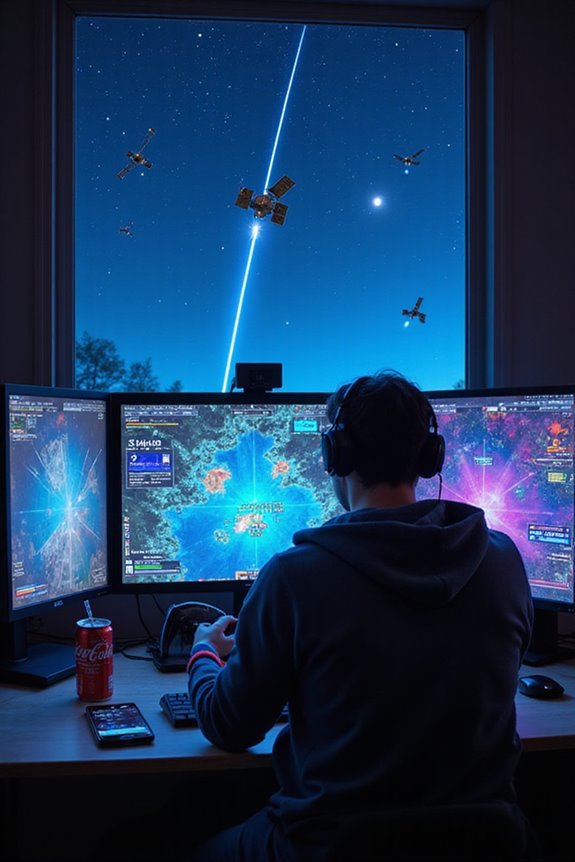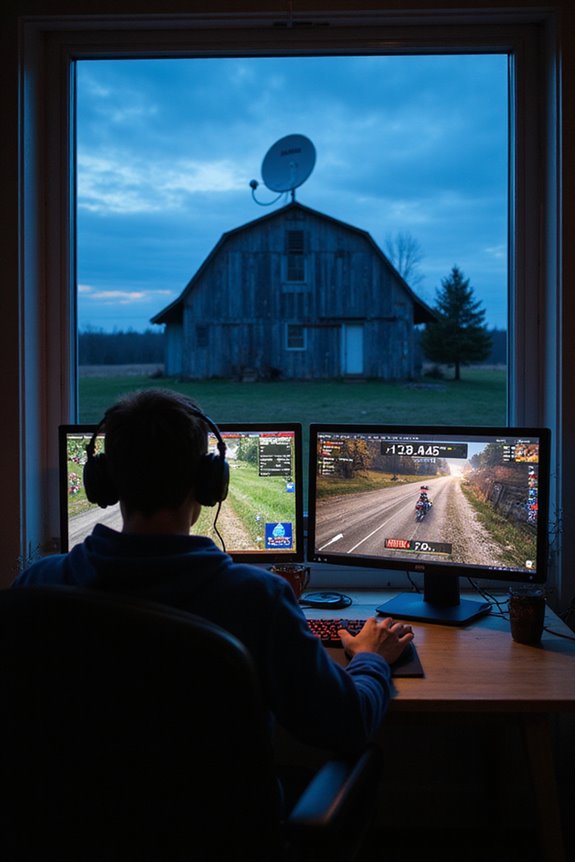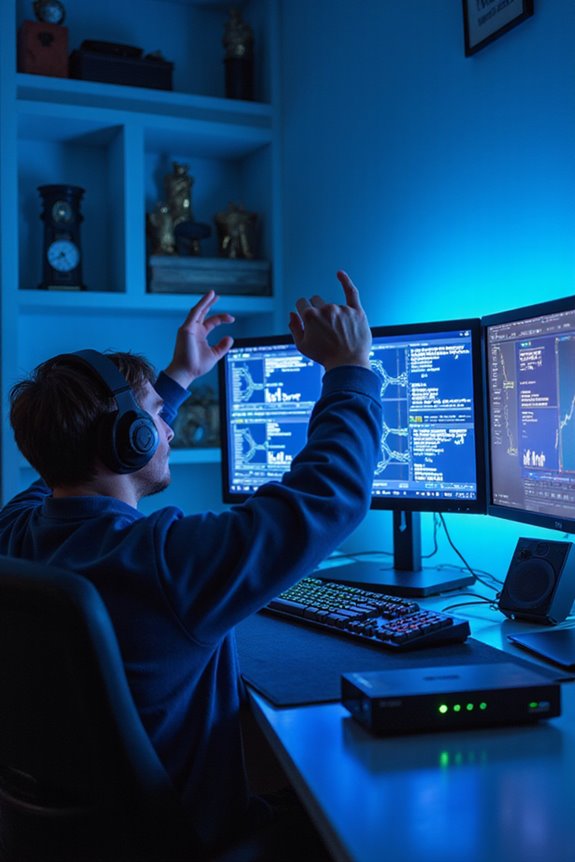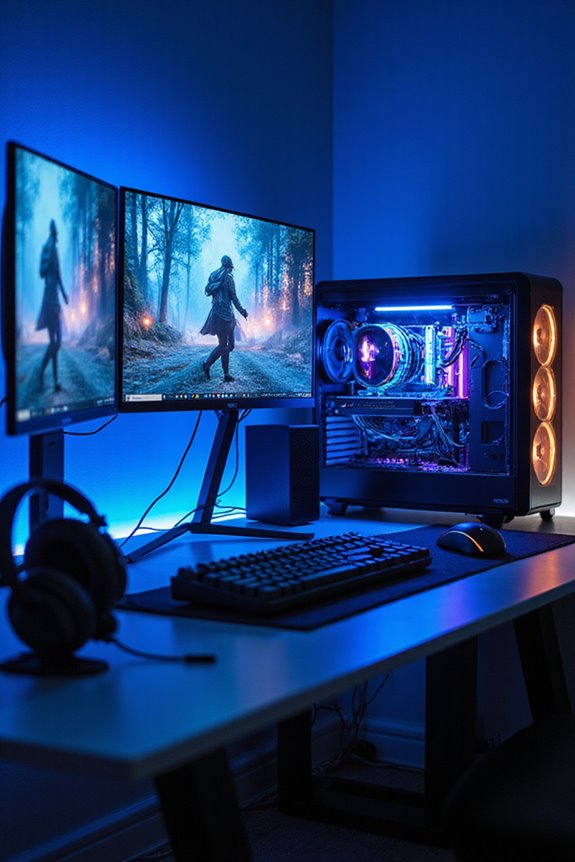Starlink can offer fast download speeds of 25 to 220 Mbps, making it a decent choice for gamers, especially with speeds often exceeding 100 Mbps. However, latency can be a mixed bag, typically ranging from 40 to 50 ms, which might lead to frustrating lag during intense gameplay. Stability is another concern, as network interruptions can occur. Still, for those in rural areas, it’s a game-changer. Stick around to discover how it all adds up for serious players.
Key Takeaways
- Starlink offers download speeds between 25 to 220 Mbps, generally suitable for competitive gaming with most users exceeding 100 Mbps.
- Latency typically ranges from 40ms to 50ms, which can disrupt fast-paced gaming experiences.
- Stability issues may arise during storms or peak hours, potentially leading to lag and disconnections.
- Upload speeds from 10 to 23 Mbps may hinder activities like streaming gameplay, limiting overall gaming experience.
- Future improvements with more satellites aim to reduce latency and enhance overall service reliability for gamers.
Understanding Starlink’s Latency for Gaming
When it comes to gaming, latency is a critical factor that can make or break your experience. Starlink promises a latency of 20 to 40 milliseconds, but in reality, I often see it range from 40ms to 50ms, occasionally spiking above 100ms. These unpredictable latency spikes can disrupt my timing in fast-paced games, making every shot feel like a gamble. While Starlink’s latency is lower than traditional satellite options, it still can’t compete with the consistency of fiber or cable. If I’m in a competitive match, even a small delay can mean the difference between victory and defeat. So, while Starlink’s an upgrade for remote gamers, it does have its quirks that we need to keep in mind.
Download Speeds: Are They Enough for Gamers?

Starlink’s download speeds can make a real difference for gamers, especially when you consider how critical speed is for online play. Typically ranging from 25 to 220 Mbps, most users enjoy speeds over 100 Mbps, which is great for competitive gaming. For casual gamers, speeds of at least 50 Mbps are recommended, and Starlink generally meets or exceeds that.
However, it’s worth noting that speeds can fluctuate due to congestion, especially during peak hours. While many report satisfaction with these speeds, latency can still be a concern. As Starlink expands its satellite fleet, I’m hopeful for improvements in both speed and reliability. After all, we all want that sweet spot of smooth gameplay without the dreaded lag, right?
The Impact of Stability on Your Gaming Experience

Stability is essential for an enjoyable gaming experience, especially if you want to avoid the frustration of lag and disconnections. Network interruptions can be a real mood killer, particularly during heavy storms or peak hours when everyone’s online. I’ve noticed that physical obstacles, like trees or buildings, can interfere with Starlink’s signal, leading to drops. That said, Starlink is generally more stable than older satellite options, and recent updates have reduced those pesky connection issues.
If you want to maximize your gaming experience, consider limiting connected devices and optimizing your router placement. While Starlink works great for casual gaming, those seeking ultra-low latency for competitive play might find it lacking. But overall, it’s a solid choice, especially in rural areas.
Latency Variability: What You Need to Know

Gaming online is all about that seamless experience, and latency plays a huge role in making or breaking it. With Starlink, you can expect typical latency ranging from 30 to 50 milliseconds, which is pretty competitive for gaming. However, here’s the kicker—latency can fluctuate greatly, sometimes jumping from 20 ms to 90 ms during a session. This variability can be frustrating, especially in fast-paced games like first-person shooters. While Starlink’s satellite technology has its perks, it also means that network congestion can worsen latency spikes. I’ve felt the difference when trying to land that perfect headshot. It’s vital to keep an eye on those latency numbers if you want to maintain your edge in the game.
Rural Connectivity: Starlink as a Game Changer

In a world where fast internet is often taken for granted, those of us living in rural areas can feel a bit left out, especially when it comes to online activities like gaming. Starlink is a game changer, providing access where traditional broadband falls short. With download speeds between 50 Mbps and 200 Mbps, it opens doors for rural gamers like me, allowing us to join online communities we once thought were out of reach. The lower latency compared to older services means a smoother gaming experience, with fewer interruptions. Plus, it’s cost-effective and avoids the infrastructure hurdles that plague traditional providers. Finally, Starlink’s potential for continuous improvement keeps hope alive for even better performance down the line.
Limitations of Upload Speeds for Online Gaming
While Starlink has made significant strides in providing internet access to rural areas, the limitations of its upload speeds can be a real concern for gamers. With typical upload speeds ranging from 10 to 23 Mbps, I find it can be quite limiting for high-bandwidth activities. Sure, casual gaming might be fine, but streaming gameplay? That’s where the struggle begins, especially if speeds drop below 10 Mbps. Compared to traditional cable internet, which often offers higher upload rates, Starlink feels a bit lacking for heavy online activity. Plus, network congestion and local infrastructure can affect consistency, making it challenging during peak hours. As someone who loves gaming, I wish for more reliable upload speeds to truly elevate the experience.
Future Improvements: What to Expect From Starlink
As Starlink continues its mission to enhance internet connectivity, I’m excited about the future improvements on the horizon. With over 4,000 satellites in orbit, the expansion promises better coverage and network capacity. This means more of us can enjoy faster speeds and reduced lag, especially with initiatives like Starlink Priority, which prioritizes data for gaming.
Moreover, SpaceX is working hard to bring latency down to below 20 milliseconds. Consistent low latency can make all the difference in competitive gaming. While pricing adjustments are expected, tailored plans should offer better value for gamers. I’m hopeful that Starlink’s commitment to bridging the digital divide will make gaming accessible in more rural areas. It’s an exciting time for online gaming enthusiasts!
Network Congestion and Its Effects on Gameplay
Starlink’s advancements are exciting, but network congestion can put a damper on the gaming experience. When too many users log on simultaneously, speeds can plunge below 10 Mbps, making even basic tasks tricky. I’ve felt the frustration when latency spikes, turning my fast-paced games into a laggy mess. It’s especially common during peak hours in densely populated areas, and that’s when I notice my aim goes off and my reactions slow down.
While speeds can hit 200 Mbps outside congestion, they’re unpredictable, and I’ve experienced rapid swings that leave me feeling disconnected. It’s a challenge, but knowing to avoid peak times can help. Monitoring real-time speeds via Starlink’s map is a lifesaver for managing expectations, don’t you think?
Competitive Gaming: Is Starlink a Suitable Choice?
Is Starlink really a viable option for competitive gaming? While its latency has improved to between 20 and 40 ms, that’s still not the best for fast-action games like first-person shooters, where every millisecond counts. I’ve noticed that latency spikes can hit above 100 ms during peak hours, and that can be a real game-changer. Stability is another concern; weather or obstacles can disrupt connectivity and throw off your gameplay. Starlink does offer decent speeds of 100 to 400 Mbps, which is generally enough for most gaming needs. However, if you’re serious about competitive gaming, you might find traditional cable or fiber-optic services offer more consistent performance. It’s a mixed bag, but Starlink is making strides.
Bridging the Digital Divide: Starlink’s Role in Gaming Expansion
In remote areas where traditional broadband barely reaches, Starlink’s satellite technology is making a noticeable impact on gaming accessibility. It’s fantastic to see how this service connects gamers worldwide, especially in regions once left in the digital dark. With download speeds between 50 Mbps and 200 Mbps, plus latency of 30 to 50 milliseconds, it offers a solid gaming experience, particularly for casual players and strategy games.
Frequently Asked Questions
How Does Weather Affect Starlink’s Gaming Performance?
I’ve noticed that weather really affects Starlink’s gaming performance. Heavy rain or storms can slow speeds and increase lag, making it frustrating. However, it usually recovers quickly, which helps during those pesky interruptions.
Can Multiple Users Game Simultaneously on Starlink?
I’ve found that multiple users can game simultaneously on Starlink, but it often leads to network congestion. If you’re all playing, you might notice slower speeds and increased latency. Prioritizing settings helps a lot!
What Devices Are Compatible With Starlink for Gaming?
You know, it’s like unsealing a treasure chest; Starlink opens up gaming on laptops, consoles, and even mobile devices. I’ve enjoyed seamless play on all my gadgets, making gaming accessible wherever I go.
Is There a Data Cap for Starlink Users?
Yes, Starlink has a Fair Use Policy instead of strict data caps. I’ve noticed that during peak times, speeds can be throttled for heavy users, but I’m not disconnected after reaching any threshold.
How Does Starlink Compare to Traditional Internet Providers for Gaming?
Imagine gaming in the countryside, where Starlink’s faster speeds and decent latency bring joy, unlike traditional providers. Yet, I’ve felt the occasional lag. It’s a mixed experience, but a lifeline for rural gamers like me.





